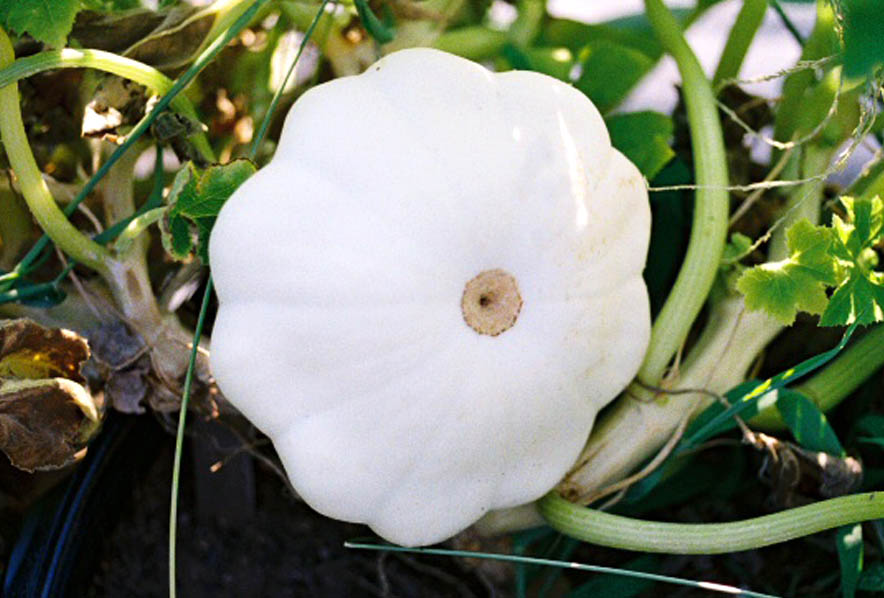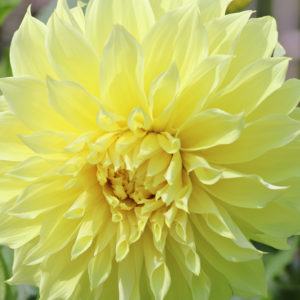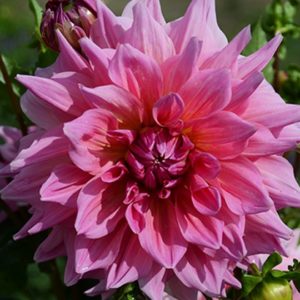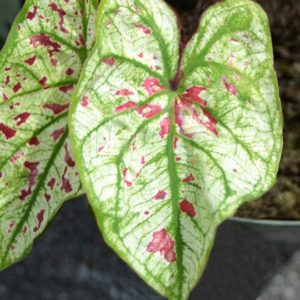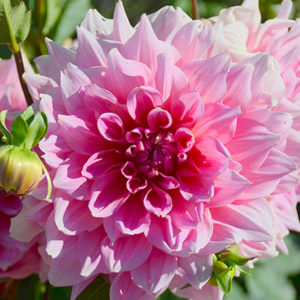Description
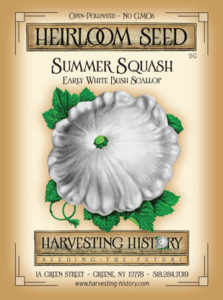 Summer Squash, Early White Bush Scallop
Summer Squash, Early White Bush Scallop
Squash, beans and corn, known as the “Three Sisters” comprised the trinity that was the staple diet of ancient America. Unbelievably, remains of wild or, possibly, cultivated squash have been found in Mexico that date to 9000 BC. Similar archaeological evidence has been unearthed in South America, Central America and northern, North America.
The wild varieties of squash were quite small and unpleasantly bitter tasting. Ancient peoples were not attracted to these vegetables for food. Instead, it is hypothesized, that ancient peoples collected the squash and dried them to make rattles and instruments for ceremonies and containers for storage and eating. Eventually, the ancient peoples came to appreciate and value the squash seeds which were rich in nutritious oils. After, perhaps centuries, ancient farmers began to select for and cultivate varieties of squash that produced pleasant tasting flesh.
The squash family can generally be divided into two classes – winter squash and summer squash – and fundamentally four species: c. maxima, c. mixta, c. moschata and c. pepo. Of the four species, three represent both summer and winter squash. The maximas are exclusively winter squash.
C. maxima are native to Bolivia and Argentina. They are the biggest fruits on earth. Some weigh more than 1000 pounds. The first maximas appeared in seed lists around 1830. Today’s giant pumpkins have all descended from a popular French maxima variety known as Jaune Gros de Paris.
C. mixta are believed to be native to Guatemala and some areas of the southwestern United States where they have been cultivated since ancient times. This group includes the winter squash known as cushaws. Mixtas are drought tolerant and their flesh is stringier and less flavorful than other squash.
C. moschata are native to the tropical areas of Central and South America. They grow best in high humidity and warm nighttime temperatures. The plants have very large leaves, long vines, and five sided stems. Butternut squash is a member of this group.
C. pepo is the family of squash that includes zucchini and most of the varieties of summer squash. These squash grow on bushy or vining plants and are eaten in their immature stage when they are still tender. The group also includes many of the pumpkins used for pies and carving as Jack O’ Lanterns. Acorn squash are also part of this group.
Many novice gardeners are lured by the evil “the earlier the better” preachings into starting squash seeds indoors – sometimes as early as March or April. Don’t do this. You gain absolutely nothing in terms of a speedy harvest. Squash should always be direct seeded when the soil has warmed considerably. Summer squash, like winter squash, pumpkins, melons, watermelons and zinnias do not like cool, damp soil. The closer your soil temperature is to 80 degrees Farenheit, the happier your seeds will be.
This means that squash should be planted in mid to late June and if you do this you will avoid many insect and fungal problems. One of the most ubiquitous and discouraging problems is the Squash Borer. In another three weeks. Harvesting History will be inundated with calls from desperate gardeners asking us if there is any way to protect their squash plants from squash borers.
Well, there is, but most callers do not like the answer.
The way to protect your squash from squash borers is to plant the squash, FROM SEED, in late June. Squash Borers are native to the US, east of the Rocky Mountains. The borer is the larva stage of the Clearwing Moth. The Clearwing Moth is a wasplike insect with copper-green forewings and orange and black abdomen.
The borer winters over in a cocoon located 1-2 inches below the surface of the soil.
The Clearwing Moth hatches out of its cocoon when the squash vine begins to vine and lays single, oval, brown eggs on the stems and leaf stalks of the vine.The borers hatch in about a week and tunnel into the vine to eat. After feeding from 4-6 weeks, the borer returns to the soil where it builds a cocoon and rests for the winter.
In the Gulf Coast region of the South, there are two generations of the borer, so our advice is not so effective along the Gulf Coast, but for the rest of the US, planting your squash in late June or early July after the borers have finished eating and are buried in the soil will eliminate or reduce the problem.
Another deterrent is to plant radishes and nasturtiums in your squash patch. The Clearwing Moth does not like either of these two plants, especially the radish. We heartily recommend planting radishes with your squash plants.
As you read about companion planting, spearmint, peppermint, catnip and tansy are suggested deterrents for squash bugs. Spearmint, peppermint and tansy are far too invasive unless you plant them in pots and we all know how much cats love catnip and how they adore rolling in a patch of catnip. If you want flattened squash plants add catnip to your squash garden.
Planting Squash and Pumpkins
Prior to planting your squash seeds, work generous amounts of compost or dried manure into the soil because squash and pumpkins love rich, well-drained soil. Never crowd squash. Competition for sun, space or nutrients will decrease the number of female flowers and thus the production.
For your vining squash, build soil hills that are approximately 6-10 inches high and 2-3 feet in diameter. Plant 6-8 seeds per hill and when the seeds have sprouted, choose the 4 strongest seedlings and remove the rest. The seedlings require at least 12 inches between plants. For bush varieties, build smaller soil hills, 4-6 inches high and 8-12 inches in diameter. For bush varieties, hills should be 30 inches apart. For vining varieties, hills should be 5 feet apart. Covering the hills with 6 mm black polyethylene plastic is recommended. The plastic keeps the soil warm, protects against insects and soil borne pathogens, reduces weeding and leads to earlier and higher yields.
Fertilize every 3-4 weeks with a fertilizer that is strong in potassium and phosphorus and low in nitrogen. TomatoTone is an excellent fertilizer for this application. Stop fertilizing when the fruit has begun to mature.
Harvest summer squash when it is still young and tender – usually when the plants are 4-8 inches long or the patty pans are 3 inches in diameter. The more you pick summer squash, they more they will produce. If the squash get overgrown, harvest and use them for baking.
Planting Squash and Pumpkins in Containers
Squash love containers, specifically 14-inch diameter containers. Fill the pot with a soil mix that is 60% topsoil, 20% dehydrated manure and 20% peat moss. Check out our YouTube video on the best soil mix for containers.
The Best Soil Mix for Containers
For vining varieties, plant 4-6 seeds in a 14-inch pot once the soil temperature has risen into the 70s. For bush varieties, plant 2-3 seeds in the middle of the container.Plant the seeds 1 inch deep and water thoroughly. Once the seeds have sprouted, for vining varieties, choose the two strongest seedlings and remove the rest. For bush varieties, choose the strongest seedling and remove the rest leaving one plant per container.Fertilize every two weeks with a fertilizer that is strong in potassium and phosphorus and low in nitrogen. TomatoTone is an excellent fertilizer for this application. Stop fertilizing when the fruit has begun to mature.

